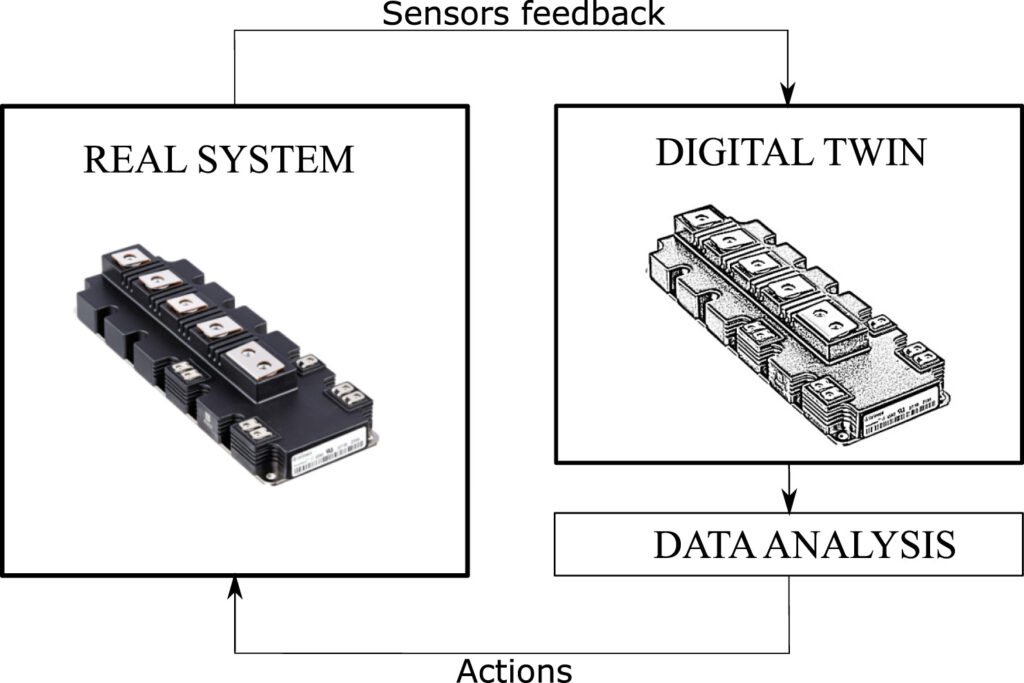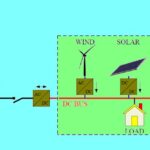A digital twin (DT) is a virtual representation of a physical system that spans its lifecycle, is updated using real-time data, and combines simulation, virtual testing, and machine learning to enable cross-functional teams to work collaboratively. Because it’s updated with real-time data, a DT creates a fusion between a modeling environment and real objects that’s not possible with traditional approaches. DTs are widely used when developing complex cyber-physical systems in mil/aero, energy, transportation, medical and other industries.
This FAQ briefly explores the use of DTs in model-based system engineering (MBSE), then presents examples of how those concepts are being adopted to improve condition monitoring of three-phase power converters, remotely updating feedback controllers for motion control, how DTs relate to power grid predictive maintenance, and closes by considering DT systems (DTS) and a system of DT systems (SDTS) and how they relate to sustainable energy grids like wind turbine farms.
MBSE is a lifecycle approach. According to the International Council on Systems Engineering (INCOSE), MBSE is the formalized use of modeling, including developing system requirements, design, testing, verification, and validation, through operational life to end of use. The DT is a basic part of MBSE and provides a link between the real and virtual worlds. Figure 1 uses an IGBT module to present the elements of DT integration as applied in MBSE, including:
- The DT is a sufficiently detailed virtual replica of the physical system to enable accurate and detailed simulations of subsystem and system behavior.
- Sensors on the real IGBT module provide the voltages and currents to be measured and serve as inputs to the digital model.
- Data analysis includes processing the responses of the modeled DT and improving its accuracy relative to the physical system.
- Actions can be taken based on the results of the data analysis to improve the performance of the physical system.

100 kW 3-phase UPS condition monitoring
A closed-loop DT has been used to model the performance of a 100 kW three-phase uninterruptible power system (UPS) and monitor/predict the state and degradation of the output LC filter. The UPS employs a 3-level voltage sourced converter (VSC) topology. The DT includes real-time embedded computing to track the functioning of the system. It also has adaptive controls that can respond to changes in the condition of the converter, enabling an extended service life.
The DT control loop emulates both island and grid following modes (Figure 2). In islanding mode, a grid-forming control scheme is used to maintain the frequency and output voltages (eaload, ebload and ecload) at their nominal values. When the grid is available, a grid following the control scheme has the primary function of charging the battery as needed to maintain an adequate state of charge to ensure energy availability should the power grid fail.

This demonstration of a DT for a complete three-phase UPS included the ability to implement the DT on a low-cost processor board and validates the concept of DTs for general use with power electronic systems. The DT produced similar output waveforms and nearly identical operation compared with the physical UPS. And the optimization method enabled the DT to follow component degradation in the real-world system and support condition monitoring of the power converter components.
Motion feedback controllers
In another demonstration of condition monitoring, a DT was used to design a feedback controller in a dynamic motion system to support improved stability and to update the controller in real time to maintain optimal operation. The DT was used to track changing behavior, including the connection between the driving motor and the structure subject to backlash. A PID control scheme is used, and the system condition is monitored for the effects of an increase in the width of the backlash gap in the lead screw that converts the motor’s rotation into translational motion. The structure can oscillate if the backlash gap is too large. The DT is used to estimate the changing backlash gap in the lead screw and alter the dead zone of the controller design to compensate.
While the feedback controller needs to be collocated with the structure being controlled and needs to operate in real time, the DT can be remotely located with an asynchronous link between it and the physical system (Figure 2). In addition, the DT can be operated faster than real time, speeding up the controller design process. Using the fast-processing DT to track changing backlash conditions enables the controller to be returned as needed to maintain stability even when the backlash varies over a wider range than a local feedback controller can handle.

Power grid predictive maintenance
DTs for power grid predictive maintenance integrate the IoT, artificial intelligence, machine learning, and analytics to create real-time digital simulation models that update and change as their physical counterparts in the power grid change. Data from multiple sensors and other sources are used to update the DT in real-time, enabling continuous learning. Other data sources can include inputs from human experts, information on the operation of other similar assets or fleets of assets, and the general operating environment.
A DT can also capture and use historical data from previous assets. In the field of predictive maintenance, historical information from the asset and similar assets is an important aspect of DT’s overall database. Each device has its own unique DT in a large fleet of similar assets, like the transformers or capacitors in a utility power grid. Each DT can capture the historical fault behavior of other devices, combine that data with the operational status of the device it’s modeling, and make specific projections about its health and potential faults.
The concept can be extended to fleet operation. And DTs can be used to simulate hundreds of future operational scenarios and determine how weather, fleet size, and various operating conditions can impact device and fleet performance. DTs can also be used to optimize the sustainability of energy installations like wind farms.
Sustainable energy
In a sustainable energy installation like a wind farm, a DT can be developed for each individual turbine, and the resulting DTS and SDTS can be used to increase the sustainability of the overall operation. There are five general elements for each DTS, including (Figure 4):
- The physical asset or physical counterpart to the DTS. The physical asset also includes the interface and control system connecting to the DTS. The physical asset and DT comprise numerous sub-elements, including IGBT modules, the drive train, the generator, interconnects to the local power grid, etc.
- The virtual model is a physics and data-driven model of the physical asset used by the DT that produces virtual measurements and performance projections. It can be used for performance optimization, fault predictions, and other functions.
- The data includes the real measurements from the physical asset and the virtual measurements from the virtual model. It can consist of both real-time and historical information.
- Data represents the stored version of (real) measurements from the physical asset, virtual measurements from the virtual model, and any predictions of expected events.
- Services provide the DTS functionality and can include intrinsic and extrinsic services. Intrinsic services are essential to the architecture of the DTS and its functionality. Extrinsic services extend the functionality of the DTS into ancillary activities like predictive maintenance and operational coordination of multiple similar assets.
- Numerous connections or communication channels are needed to tie together the diverse elements of the physical asset and the DTS, including the data exchanges, the flows of real and virtual measurements, and automated and virtual actions. These connections support the synchronization of information needed to coordinate the DTS with the physical asset.

Summary
DTs, DTS and SDTS, are important elements in MBSE. They include virtual representations of physical systems that span their lifecycles, are updated using real-time data, including data related to the operating environment, and combine simulation, virtual testing, and machine learning. The concept of a DT can be applied to relatively simple systems like IGBT modules, power converters, motion control systems, and massive installations like power grids and wind farms.
References
A real-time digital twin approach on three-phase power converters applied to condition monitoring, Applied Energy
Digital Twins for the Future Power Systems, MDPI sustainability
Digital Twins for Modern Power Systems, Opal-RT Technologies
Predictive Maintenance of Power Grid Assets, Vecto Systems
Predictive maintenance using digital twins, ResearchGate
The use of digital twins to remotely update feedback controllers for the motion control of nonlinear dynamic systems, Mechanical Systems, and Signal Processing
What is Digital Twin?, IBM







Leave a Reply